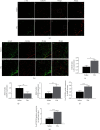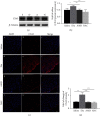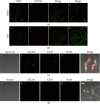CXCR4/CX43 Regulate Diabetic Neuropathic Pain via Intercellular Interactions between Activated Neurons and Dysfunctional Astrocytes during Late Phase of Diabetes in Rats and the Effects of Antioxidant N-Acetyl-L-Cysteine
- PMID: 35799894
- PMCID: PMC9256426
- DOI: 10.1155/2022/8547563
CXCR4/CX43 Regulate Diabetic Neuropathic Pain via Intercellular Interactions between Activated Neurons and Dysfunctional Astrocytes during Late Phase of Diabetes in Rats and the Effects of Antioxidant N-Acetyl-L-Cysteine
Abstract
Growing evidence suggests that the interactions between astrocytes and neurons exert important functions in the central sensitization of the spinal cord dorsal horn in rodents with diabetes and neuropathic pain (DNP). However, it still remains unclear how signal transmission occurs in the spinal cord dorsal horn between astrocytes and neurons, especially in subjects with DNP. Chemokine CXC receptor 4 (CXCR4) plays critical roles in DNP, and connexin 43 (CX43), which is also primarily expressed by astrocytes, contributes to the development of neuropathy. We thus postulated that astrocytic and neuronal CXCR4 induces and produces inflammatory factors under persistent peripheral noxious stimulation in DNP, while intercellular CX43 can transmit inflammatory stimulation signals. The results showed that streptozotocin-induced type 1 diabetic rats developed heat hyperalgesia and mechanical allodynia. Diabetes led to persistent neuropathic pain. Diabetic rats developed peripheral sensitization at the early phase (2 weeks) and central sensitization at the late phase (5 weeks) after diabetes induction. Both CXCR4 and CX43, which are localized and coexpressed in neurons and astrocytes, were enhanced significantly in the dorsal horn of spinal cord in rats undergoing DNP during late phase of diabetes, and the CXCR4 antagonist AMD3100 reduced the expression of CX43. The nociceptive behavior was reversed, respectively, by AMD3100 at the early phase and by the antioxidant N-acetyl-L-cysteine (NAC) at the late phase. Furthermore, rats with DNP demonstrated downregulation of glial fibrillary acidic protein (GFAP) as well as upregulation of c-fos in the spinal cord dorsal horn at the late phase compared to the controls, and upregulation of GFAP and downregulation of c-fos were observed upon treatment with NAC. Given that GFAP and c-fos are, respectively, makers of astrocyte and neuronal activation, our findings suggest that CXCR4 as an inflammatory stimulation protein and CX43 as an intercellular signal transmission protein both may induce neurons excitability and astrocytes dysfunction in developing DNP.
Copyright © 2022 Dan Zhu et al.
Conflict of interest statement
This study is claimed to show no conflicts of interest.
Figures










Similar articles
-
Progressive Increase of Inflammatory CXCR4 and TNF-Alpha in the Dorsal Root Ganglia and Spinal Cord Maintains Peripheral and Central Sensitization to Diabetic Neuropathic Pain in Rats.Mediators Inflamm. 2019 Mar 14;2019:4856156. doi: 10.1155/2019/4856156. eCollection 2019. Mediators Inflamm. 2019. PMID: 31001066 Free PMC article.
-
Connexin-43 induces chemokine release from spinal cord astrocytes to maintain late-phase neuropathic pain in mice.Brain. 2014 Aug;137(Pt 8):2193-209. doi: 10.1093/brain/awu140. Epub 2014 Jun 11. Brain. 2014. PMID: 24919967 Free PMC article.
-
CXCL12/CXCR4 signaling contributes to neuropathic pain via central sensitization mechanisms in a rat spinal nerve ligation model.CNS Neurosci Ther. 2019 Sep;25(9):922-936. doi: 10.1111/cns.13128. Epub 2019 Apr 7. CNS Neurosci Ther. 2019. PMID: 30955244 Free PMC article.
-
Activated microglia in the spinal cord underlies diabetic neuropathic pain.Eur J Pharmacol. 2014 Apr 5;728:59-66. doi: 10.1016/j.ejphar.2014.01.057. Epub 2014 Feb 6. Eur J Pharmacol. 2014. PMID: 24508519 Review.
-
Spinal neuron-glial crosstalk and ion channel dysregulation in diabetic neuropathic pain.Front Immunol. 2025 Apr 8;16:1480534. doi: 10.3389/fimmu.2025.1480534. eCollection 2025. Front Immunol. 2025. PMID: 40264787 Free PMC article. Review.
Cited by
-
The role of astrocytes in neuropathic pain.Front Mol Neurosci. 2022 Sep 20;15:1007889. doi: 10.3389/fnmol.2022.1007889. eCollection 2022. Front Mol Neurosci. 2022. PMID: 36204142 Free PMC article. Review.
-
Spinal astrocytes involved in the pathogenesis and treatment of neuropathic pain.Front Cell Neurosci. 2025 Feb 21;19:1547524. doi: 10.3389/fncel.2025.1547524. eCollection 2025. Front Cell Neurosci. 2025. PMID: 40062207 Free PMC article. Review.
-
The Double-Edged Effect of Connexins and Pannexins of Glial Cells in Central and Peripheral Nervous System After Nerve Injury.Mol Neurobiol. 2025 May 1. doi: 10.1007/s12035-025-04991-6. Online ahead of print. Mol Neurobiol. 2025. PMID: 40310549 Review.
-
Annulus Fibrosus Injury Induces Acute Neuroinflammation and Chronic Glial Response in Dorsal Root Ganglion and Spinal Cord-An In Vivo Rat Discogenic Pain Model.Int J Mol Sci. 2024 Feb 1;25(3):1762. doi: 10.3390/ijms25031762. Int J Mol Sci. 2024. PMID: 38339040 Free PMC article.
-
Ginger alleviates mechanical hypersensitivity and anxio-depressive behavior in rats with diabetic neuropathy through beneficial actions on gut microbiome composition, mitochondria, and neuroimmune cells of colon and spinal cord.Nutr Res. 2024 Apr;124:73-84. doi: 10.1016/j.nutres.2024.01.014. Epub 2024 Feb 1. Nutr Res. 2024. PMID: 38402829 Free PMC article.
References
MeSH terms
Substances
LinkOut - more resources
Full Text Sources
Medical
Molecular Biology Databases
Miscellaneous

